Difference between Top-Down and Bottom-Up Integration Testing
In this section, we are going to discuss the difference between top-down and bottom-up integration testing; and see a brief introduction of them.
As we understood in the earlier section of software testing, every software or application encompasses various modules that are contrary to each other through an interface.
When each component or module works independently of an application, we need to check the dependent modules' data flow, known as integration testing. It is a significant part of Functional testing.
Before we see the top-down and bottom-up integration testing approaches in detail, we need to understand incremental integration testing as top-down and bottom-up integration testing is an integral part of it.
Incremental Integration Testing Approach
- Incremental testing is the most vital part of integration testing. The modules are added in ascending order one by one as per the customer's need. And the selected modules need to be related logically to each other.
- Usually, two or more modules are added and tested to fix the precision of functions. And, the process will continue until all the modules or components are tested s successfully.
- In simple words, we can say that when there is a strong relationship between the dependent modules, we will perform the incremental integration testing.
Now, let look into the definition and basic working of top-down and bottom-up incremental integration testing.
What is Top-down Integration Testing?
- In top-down incremental integration testing, we will add the modules incrementally or one by one and test the data flow in similar order as we can see in the below diagram:
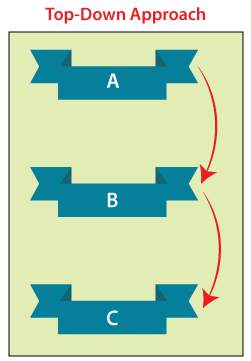
- This testing technique deals with how higher-level modules are tested with lower-level modules until all the modules have been tested successfully.
- In the top-down method, we will also make sure that the module we are adding is the child of the previous one, like Child C, is a child of Child B.
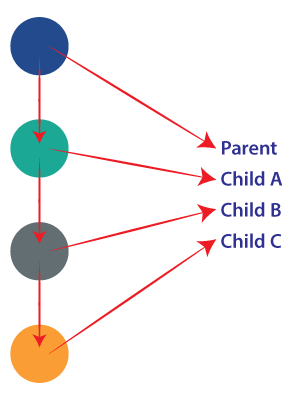
- The purpose of executing top-down integration testing is to detect the significant design flaws and fix them early because required modules are tested first.
What is Bottom Up Integration Testing?
The next testing approach we are talking about is bottom-up integration testing.
- This type of testing method deals with how lower-level modules are tested with higher-level modules until all the modules have been tested successfully.
- In bottom-up testing, the top-level critical modules are tested, at last. Hence it may cause a defect.
- In simple words, we can say that we will be adding the modules from the bottom to the top and test the data flow in similar order as we can see in the below image:
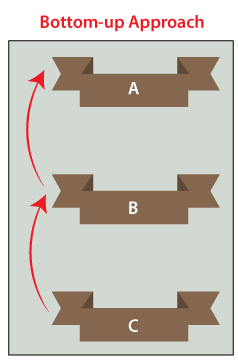
- In the bottom-up method, we will ensure that the modules we are adding are the parent of the previous one as we observe in the following image:
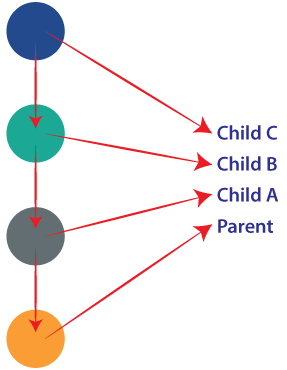
Key difference between top-down and bottom-up incremental integration testing
The below facts explain the critical differences between top-down and bottom-up integration testing, which will allow test engineers to create an informed decision regarding which type of integration testing approach they want to select for the different testing processes.
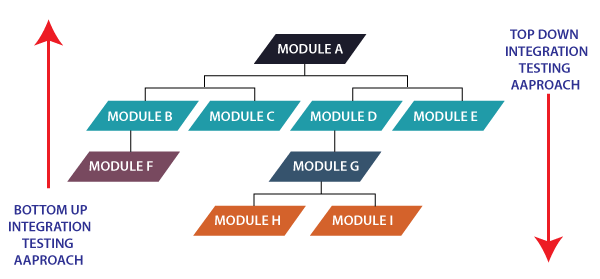
- The top-down integration testing approach is simple and not data-intensive; on the other hand, the bottom-up integration testing approach is complex and data-intensive.
- The process of top-down integration testing is much simpler as compared to bottom-up integration testing.
- Top-down approaches are backward-looking; on the other hand, the bottom-up approaches are forward-looking.
- The top-down integration testing works through significant to minor components, whereas the bottom-up approach works through small to essential components or modules.
- Top-down approach analyses the risk by collecting the impact of internal operational failures, whereas the bottom-up approach analyses the risks in individual processes with models' help.
- In the top-down approach, the stubs are used to simulate the submodule, which implies that the Stub works as a momentary replacement. On the other hand, in the bottom-up testing approach, the drivers simulate the main module, which means that the Driver works as a momentary replacement.
Top-Down Integration Testing VS Bottom-Up Integration Testing
We have discussed some significant comparisons between Top-Down Integration Testing and Bottom-Up Integration Testing in the below table:
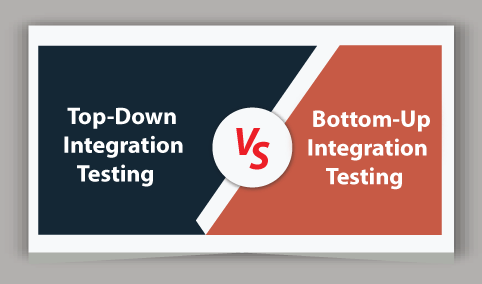
| S.NO. |
Comparison Basis |
Top-Down Integration Testing |
Bottom-up Integration Testing |
| 1. |
Definition |
We will add the modules incrementally or one by one and test the data flow in similar order. |
The lower-level modules are tested with higher-level modules until all the modules have been tested successfully. |
| 2. |
Executed on |
The top-down integration testing approach will be executed on the Structure or procedure-oriented programming languages. |
The bottom-up integration testing approach will be executed on Object-oriented programming languages. |
| 3. |
Observation |
In the top-down approach, the observation of test output is more complicated. |
In the bottom-up approach, the observation of test output is more accessible. |
| 4. |
Risk analysis |
We are collaborating on the impact of internal operational failures. |
To analyze the individual process, we can use the Models. |
| 5. |
Work on |
The top-down integration testing approach will work on major to minor components. |
The bottom-down integration testing approach will work on the miner to significant components. |
| 6. |
Complexity |
The complexity of the top-down approach is simple. |
The complexity of the bottom-up approach is complex and highly data intensive. |
| 7. |
Stub/Driver creation |
Stub modules must be created in the top-down testing approach. |
The driver modules must be created in the bottom-up testing approach. |
| 8. |
Managed from |
It is performed from main-module to sub-module. |
It is performed from the sub-module to the main module. |
| 9. |
Advantage |
Following are some of the significant benefits of using top-down integration testing:
- In this, the early prototype is possible.
- Fault Localization is easier.
|
Below are some of the essential advantages of using bottom-up integration testing:
- We do not need to wait for the development of all the modules as it saves time.
- Identification of defects is easy.
|
| 10. |
Disadvantage |
Some of the most common drawbacks of the top-down approach are as follows:
- Lower-level modules are tested ineffectively.
- Due to the high number of stubs, it gets pretty complicated.
- Critical Modules are tested first so that fewer chances of defects.
|
The disadvantage of the bottom-up approach is as follows:
- Compulsory modules are tested last, due to which the defects can occur.
- There is no possibility of an early prototype.
|
Conclusion
In this tutorial, we have made a comparison between top-down and bottom-up incremental integration testing.
Here, we have concluded that the execution of top-down and bottom-up approaches is required to test the software or the application.
The top-down testing technique is the most commonly used Integration Testing Type. It is an integration testing technique used to imitate the lower-level modules that are not yet integrated.
The bottom-Up testing technique is a type of incremental integration testing approach implemented to evaluate the risks in the software. The most significant advantage of executing this approach is its user-friendliness which provides high deployment coverage in software development.
In both approaches, top-down and bottom-up integration testing, the top-down generates more redundant results and leads to additional efforts in the form of overheads. Equally, the bottom-up approach is challenging but more efficient than the top-down approach.
|


 For Videos Join Our Youtube Channel: Join Now
For Videos Join Our Youtube Channel: Join Now













